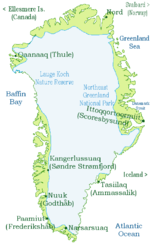Ice sheet
2008/9 Schools Wikipedia Selection. Related subjects: Geography
An ice sheet is a mass of glacier ice that covers surrounding terrain and is greater than 50,000 km² (20,000 mile²). The only current ice sheets are in Antarctica and Greenland; during the last glacial period at Last Glacial Maximum ( LGM) the Laurentide ice sheet covered much of Canada and North America, the Weichselian ice sheet covered northern Europe and the Patagonian Ice Sheet covered southern South America.
Ice sheets are bigger than ice shelves or glaciers. Masses of ice covering less than 50,000 km² are termed an ice cap. An ice cap will typically feed a series of glaciers around its periphery.
Although the surface is cold, the base of an ice sheet is generally warmer due to geothermal heat. In places, melting occurs and the melt-water lubricates the ice sheet so that it flows more rapidly. This process produces fast-flowing channels in the ice sheet — these are ice streams.
The present-day polar ice sheets are relatively young in geological terms. The Antarctic Ice Sheet first formed as a small ice cap (maybe several) in the early Oligocene, but retreating and advancing many times until the Pliocene, when it came to occupy almost all of Antarctica. The Greenland ice sheet did not develop at all until the late Pliocene, but apparently developed very rapidly with the first continental glaciation. This had the unusual effect of allowing fossils of plants that once grew on present-day Greenland to be much better preserved than with the slowly forming Antarctic ice sheet.
Antarctic ice sheet
The Antarctic ice sheet is the largest single mass of ice on Earth. It covers an area of almost 14 million km² and contains 30 million km³ of ice. Around 90% of the fresh water on the Earth's surface is held in the ice sheet, and, if melted, would cause sea levels to rise by 61.1 meters. In East Antarctica the ice sheet rests on a major land mass, but in West Antarctica the bed is in places more than 2,500 meters below sea level. It would be seabed if the ice sheet were not there.
Greenland ice sheet
The Greenland ice sheet occupies about 82% of the surface of Greenland, and if melted would cause sea levels to rise by 7.2 metres. Estimated changes in the mass of Greenland's ice sheet suggest it is melting at a rate of about 239 cubic kilometres (57.3 cubic miles) per year. These measurements came from NASA's Gravity Recovery and Climate Experiment (GRACE) satellite, launched in 2002, as reported by BBC News in August 2006 .
Ice sheet dynamics
Ice motion is dominated by the movement of glaciers, whose activity is controlled by a number of processes. Their motion is dominated by cyclic surges interspersed with longer periods of inactivity, on both hourly and centennial time scales.
Predicted effects of global warming
The Greenland, and probably the Antarctic, ice sheets have been losing mass recently, because losses due to melting and outlet glaciers have exceeded accumulation due to snowfall. According to the IPCC, loss of Antarctic ice sheet mass and Greenland ice sheet mass contributed, respectively, about 0.21 ± 0.35 and 0.21 ± 0.07 mm/year to sea level rise between 1993 and 2003.
The IPCC projects that ice mass loss from melting of the Greenland ice sheet will continue to outpace accumulation from snowfall. Accumulation from snowfall on the Antarctic ice sheet is projected to outpace losses from melting. However, loss of ice mass on the Antarctic ice sheet may continue, if there is sufficient loss of ice mass via outlet glaciers. According to the IPCC, scientific understanding of dynamical ice flow processes is currently "limited".
